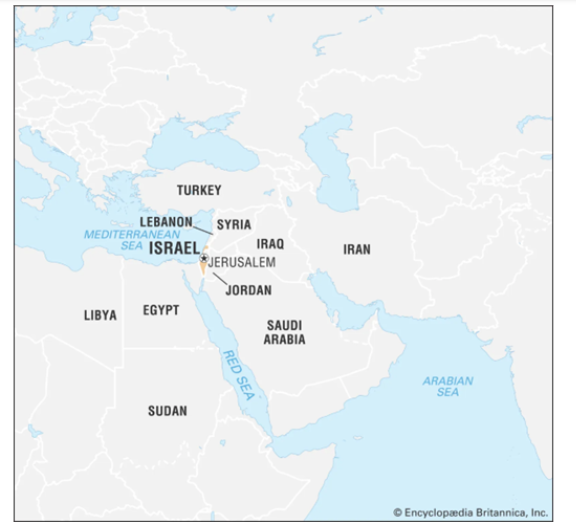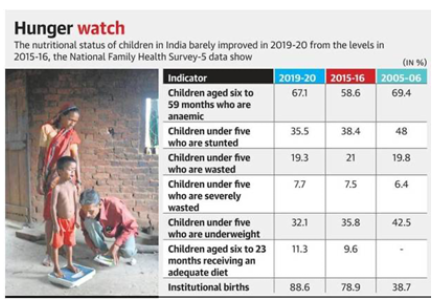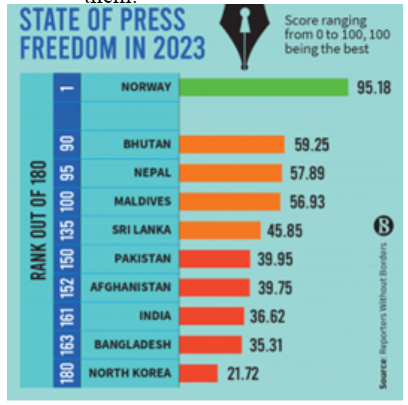Tuesday, 17th October 2023
Habitat Rights and Implications
In News: Baiga tribal group gets habitat rights in Chhattisgarh.
About
- The Chhattisgarh Government has recently granted habitat rights to the Baiga Particularly Vulnerable Tribal Group (PVTG), following the earlier granting of such rights to the Kamar PVTG in August 2023.
- This marks the second instance of habitat rights being bestowed upon a PVTG in Chhattisgarh, where there are a total of seven PVTGs, namely Kamar, Baiga, Pahadi Korba, Abujhmadiya, Birhor, Pando, and Bhujia.
About Habitat Right
- Recognition of habitat rights grants the concerned community a wide range of entitlements over their traditional habitation areas, encompassing their socio-cultural traditions, economic and livelihood practices, intellectual knowledge related to biodiversity and ecology, traditional wisdom regarding natural resource utilization, and the safeguarding and preservation of both their natural and cultural heritage.
- These habitat rights serve as a protective mechanism for the preservation and dissemination of ancestral ecological knowledge and traditional livelihood practices that have been passed down through generations. They also facilitate the coordination of various government programs and initiatives from different departments to empower Particularly Vulnerable Tribal Groups (PVTGs) to develop and enhance their living environments.
- As per the Forest Rights Act (FRA), "habitat" encompasses customary dwelling areas, as well as those located within reserved and protected forests, which are utilized by PVTGs and other forest-dwelling Scheduled Tribes.
- Habitat rights will help the PVTG protect their habitat from developmental activities harmful to them. The title may not be an ownership title in the nature of a private property owner, but consent and consultation of the gram sabha will be needed for any developmental activity.
- Forest Rights have legal protection under the Forest Conservation Act, the Land Acquisition law of 2013, and even the SC/ST Prevention of Atrocities. Act. Grant of habitat rights under the Forest Rights Act provide an additional layer of legal protection.”
- Out of the 75 PVTGs in India, only three have been granted habitat rights. The Bharia PVTG in Madhya Pradesh was the first to receive these rights, followed by the Kamar tribe, and most recently, the Baiga tribe in Chhattisgarh.
Procedure of Declaring Rights
- Consultation with Traditional Tribal Leaders: The procedure begins with consultations with traditional tribal leaders. These discussions aim to assess the cultural, traditional, and occupational aspects of the PVTG community's way of life. These insights are vital for determining the extent of the habitat that should be granted to the PVTG.
- Interdepartmental Coordination: The next step involves close coordination between various state-level departments, including Forest, Revenue, Tribal, and Panchayati Raj. These departments work together to define and declare the habitat for the PVTG. This coordination is essential to ensure that the habitat rights are granted in a well-organized and legally sound manner.
- Involvement of UNDP Team: Collaboration with the United Nations Development Programme (UNDP) team is another crucial element of the process. Their expertise and assistance can contribute to the effective recognition and declaration of habitat rights for PVTGs.
Legality of Habitat Right
- Habitat rights for PVTGs are granted under Section 3(1)(e) of the Scheduled Tribes and Other Traditional Forest Dwellers (Recognition of Forest Rights) Act, 2006.
- This legal provision is the basis for recognizing and securing the rights of PVTGs over their customary territories, which encompass their habitation, economic and livelihood means, as well as their knowledge of biodiversity.
- It's a legal framework that seeks to protect and empower these vulnerable tribal communities in India.
|
UPSC CSE Previous Year Question (PYQ) Q.1 Consider the following pairs: (2013)
Which of the above pairs are correctly matched? (a) 1 and 3 only Answer: (a) Q.2 Consider the following statements about Particularly Vulnerable Tribal Groups (PVTGs) in India: (2019)
Which of the statements given above are correct? (a) 1, 2 and 3 Answer: (c) |
Remote Voting for Migrants - Edukemy Current Affairs
In News: Recently, a survey by Lokniti-CSDS was conducted in September 2023, involving 1,017 migrants living in Delhi’s slums, with 63% men and 37% women. The aim was to understand whether the proposed R-EVM system would gain a viable level of trust among its intended users, setting aside legal and logistical concerns raised by political parties.
Remote EVM (R-EVM):
- The Election Commission of India (ECI) proposed a mechanism called Remote Electronic Voting Machine (R-EVM) to make voting easier for domestic migrants who are unable to vote in their registered constituency because of their current location.
- This system will allow registered voters who have moved away from their home constituencies to cast their votes remotely.
- Some nations, like Estonia, France, Panama, Pakistan, and Armenia, allow its residents who reside overseas or outside of their respective constituencies to vote remotely.
Proposed Mechanism of R-EVM:
- Voters interested in using the remote voting option must register (online or offline) with the relevant Returning Officer (RO) of their home constituency within a pre-notified date.
- In the vicinity of the voter's present residence, a multi-constituency remote polling station will be established, enabling remote voting from that place.
- Voters from various constituencies can efficiently cast their ballots at the same spot as the RVM can manage numerous constituencies (up to 72) from a single remote polling station.
- The relevant constituency and candidate list will appear on the RVM display when the voter scans their constituency card in the presence of the presiding officer at the remote polling location.
- The RVMs employ an electronic ballot display to exhibit candidates and their symbols rather than a fixed paper ballot sheet, and they have the same security system and voting procedure as the current EVMs.
- On the RVM display, voters can choose the candidate of their choice. The system will tally and record each candidate's vote for a constituency.
Significance of Migrant Vote:
- A substantial number of long-term migrants are present in Delhi, as indicated by the majority of migrants (61%) who have been there for more than five years.
- 53% of migrants are registered to vote in Delhi, while 27% are registered in their home states.
- In comparison to local/panchayat elections, migrants take part in national and state elections more.
- Returning to home for the polls is motivated by the opportunity to exercise one's fundamental right to vote (40%) and to spend time with family (25%).
- 31% of respondents express distrust, compared to 47% who prefer to trust the suggested remote voting option. There is a considerable gender gap, with men (50%) showing more trust than women (40%). The system is more trusted by those with higher levels of education.
Challenges with the Proposed system:
- The challenges with regard to the current EVMs will persist when it comes to the RVMs because these have the same security system which is in the EVMs.
- It requires amendments to the Representation of People’s Act of 1950 and 1951; the Conduct of Election Rules, 1961; and the Registration of Electors Rules, 1960.
- It might be difficult to maintain the integrity and confidentiality of the voting process while ensuring voting privacy in remote areas.
- A fair and secure remote voting system must incorporate measures to reliably identify voters and prevent impersonation.
- Organising poll workers and ensuring that remote voting locations are effectively supervised pose logistical and administrative difficulties.
- To avoid voter misunderstanding and mistakes, it is crucial to make sure that voters are familiar with the technologies and interfaces used for remote voting.
Way Forward:
- The voting mechanism must be independent of hardware and software in order to be verifiable and accurate; in other words, it cannot be verified purely based on the premise that the EVM is accurate.
- If a voter is dissatisfied, they should have the option to cancel their vote, and the process must be easy and involve no contact from anybody.
- It is crucial to consider the trust and acceptability of all the participants in the electoral process, including voters, political parties, and election apparatus.
https://epaper.thehindu.com/ccidist-ws/th/th_delhi/issues/55332/OPS/GT9BS7FMQ.1+GDHBS9L6O.1.html
Invisible E-Waste - Edukemy Current Affairs
In News: The Brussels-based Waste Electrical and Electronic Equipment (WEEE) Forum commissioned the United Nations Institute for Training and Research (UNITAR) on the Occasion of International E-Waste Day (14th October) to calculate the annual quantities of Invisible E-Waste items.
Key Highlights of the Study:
- Invisible E-Waste Volume:
- Consumers do not recognise approximately one-sixth of the yearly global total of nearly 9 billion kilogrammes of electronic waste.
- The e-toy category, which includes race car sets, electric trains, drones, and biking computers, accounts for around 35% of invisible e-waste (or about 3.2 billion kilogrammes).
- The annual projected 844 million vaping gadget discards add greatly to the intangible e-waste mountain.
- Invisible E-Waste Value: Every year, the material worth of invisible e-waste is estimated to be over USD 9.5 billion, demonstrating the economic significance of its components, particularly iron, copper, and gold.
- Global Scenario:
- Only a small portion of e-waste is adequately collected, handled, and recycled on a global scale. 55% of the e-waste produced in Europe is currently formally collected and documented.
- However, the claimed average collection rate in other regions of the world is little over 17%. Most of it is disposed of in landfills, burnt, illegally sold, mishandled, or hoarded in homes.
- Environmental Concerns: The improper management of hazardous components in these products, such as lead, mercury, and cadmium, can pollute land and water, making improper disposal of invisible e-waste a significant environmental issue.
- Recommendations:
- Visible e-waste is an untapped resource that emphasises the opportunity for economic growth and the pressing need to spread knowledge about recycling these valuable materials.
- In 2019, it was predicted that the worth of raw materials in the world's created e-waste was USD 57 billion.
- Sixth of the total, or USD 9.5 billion in material worth annually, belongs to the category of invisible e-waste.
- To maximise recycling potential and fulfil the expanding need for materials across a range of vital industries, such as renewable energy, electric transportation, manufacturing, communications, aerospace, and defence, it is essential to raise awareness.
Invisible E-waste:
- Electronic garbage that is frequently overlooked by customers because of its appearance or nature is referred to as invisible e-waste.
- These include cables, e-toys, e-cigarettes, e-bikes, power tools, smoke detectors, USB sticks, wearable health devices, and smart home appliances, etc.
Waste Electrical and Electronic Equipment (WEEE) Forum:
- It is the largest global centre of expertise in the world for "waste electrical and electronic equipment" operational know-how.
- It was established in April 2002 and is a non-profit association of 46 WEEE producer responsibility associations from throughout the world.
Provisions regarding E-waste in India:
- The E-waste (Management) Rules, 2016 cover over 21 goods (Schedule-I).
- With the primary goal of digitising the e-waste management process and improving visibility, the Government of India published the E-Waste (Management) Rules, 2022.
- Additionally, it prohibits the use of toxic materials (including lead, mercury, and cadmium) that are harmful to both human health and the environment when making electrical and electronic equipment.
- An additional economic tool known as the Deposit Refund Scheme has been introduced. Under this scheme, the producer charges a deposit in addition to the price of the electrical and electronic equipment at the time of sale and returns it to the customer, along with interest, when the end-of-life electrical and electronic equipment is returned.
|
UPSC CSE Previous Year Question (PYQ) Mains 2018
|
World Economic Outlook: IMF - Edukemy Current Affairs
In News: Recently, IMF in its report raised India's FY24 GDP growth forecast to 6.3% from 6.1%.
About
The IMF World Economic Outlook 2023 expects global Gross Domestic Product growth to be 3% in 2023, which is the same as its July 2023 forecast. Global GDP growth for 2024, however, has seen a reduction of 10 basis points from the July forecast to 2.9%.
Findings related to India
- India's GDP growth forecast for 2023-24 is set at 6.3%, which reflects a 20-basis point increase from the figures reported in July 2023.
- The International Monetary Fund (IMF) and the World Bank (WB) now share the same growth forecast for India in 2023-24. This aligns with what the World Bank had previously projected in its India Development Update.
- India's GDP growth forecast for 2024-25 remains unchanged at 6.3%.
- The upward revision of India's GDP growth for 2023-24 by the IMF is attributed to a robust 7.8% growth rate recorded in the quarter ending June 2023.
- It's worth noting that the annual growth forecast of 6.3% by the IMF is still lower than the 6.5% projection made by the Reserve Bank of India's (RBI) Monetary Policy Committee (MPC).
|
UPSC CSE Previous Year Question (PYQ) Prelims Q1. "Rapid Financing Instrument" and "Rapid Credit Facility" are related to the provisions of lending by which one of the following? (2022) (a) Asian Development Bank Answer: (b) Q2. “Gold Tranche” (Reserve Tranche) refers to (2020) (a) a loan system of the World Bank Answer: (d) Q3. ‘Global Financial Stability Report’ is prepared by the (2016) (a) European Central Bank Answer: (b) Mains (2013) Q. The World Bank and the IMF, collectively known as the Bretton Woods Institutions, are the two inter-governmental pillars supporting the structure of the world’s economic and financial order. Superficially, the World Bank and the IMF exhibit many common characteristics, yet their role, functions and mandate are distinctly different. Elucidate. |
Setu Bandhan Scheme: CRIF - Edukemy Current Affairs
In News: Recently, the Union Minister for Road Transport and Highways launched the Setu Bandhan Scheme for 7 bridge projects.
About
- The "Setu Bandhan Scheme" is a program initiated by the Ministry of Road Transport & Highways, aimed at facilitating the construction of Rail Over Bridges (ROBs), Rail Under Bridges (RUBs), and Bridges on State Roads.
- This program is designed to enhance road safety by replacing existing level crossings with bridges, ultimately reducing accidents at these locations.

https://pib.gov.in/PressReleaseIframePage.aspx?PRID=1967034
Goan Cashew Gets GI Tag - Edukemy Current Affairs
In News: Recently, Goan cashew (kernel) got the geographical indication (GI) tag
About
- Cashews originally had their roots in Northeast Brazil, Latin America.
- Goan Cashew was introduced to Goa by the Portuguese in 1570, during the 16th century.
- Initially, it was primarily used for afforestation and soil conservation. However, it took about a century for people to realize its economic significance.
- Cashew production evolved from being a small-scale cottage industry to becoming a major driving force behind Goa's economy, largely due to its increasing demand in the United States.
|
UPSC CSE Previous Years Questions (PYQs) Prelims Q 1. Which of the following has/have been accorded ‘Geographical Indication’ status? (2015)
Select the correct answer using the code given below: (a) 1 only Answer: (c) Q 2. India enacted the Geographical Indications of Goods (Registration and Protection) Act, 1999 in order to comply with the obligations to: (2018) (a) ILO Answer: (d) |
Five New Sports in the Olympic Games
In News: The International Olympic Committee (IOC) Session, held in Mumbai, has approved the proposal put forth by the Organising Committee of the 2028 Olympic Games in Los Angeles (LA28) to introduce five additional sports to the Olympic program.
About
- Cricket (T20), Baseball/softball, flag football, lacrosse, and squash will be in the program at LA28.
- The IOC is the guardian of the Olympic Games Established in June 1894, the IOC is a not-for-profit independent international organization.
- Based in Lausanne, Switzerland, the Olympic Capital, is entirely privately funded.
https://olympics.com/ioc/news/ioc-session-approves-la28-s-proposal-for-five-additional-sports#:~:text=Baseball%2Fsoftball%2C%20cricket%20(T20,International%20Olympic%20Committee%20(IOC).
Israel's Gaza Airstrikes Continue
GS-2 International Relation
In News: Israel has maintained punishing airstrikes across Gaza as a ground invasion looms.
About
- The State of Israel is the only Jewish nation in the modern period. It is located at the eastern end of the Mediterranean Sea.
- It is bounded to the north by Lebanon, to the northeast by Syria, to the east and southeast by Jordan, to the southwest by Egypt, and the west by the Mediterranean Sea.
- Jerusalem is the seat of government and the proclaimed capital, although the latter status has not received wide international recognition.
- Israel has four geographic regions—the Mediterranean coastal plain, the hill regions of northern and central Israel, the Great Rift Valley, and the Negev—and a wide range of unique physical features and microclimates.
- The principal drainage system comprises Lake Tiberias and the Jordan River.
- Other rivers in Israel are the Yarqon, which empties into the Mediterranean near Tel Aviv; the Qishon, which runs through the western part of the Plain of Esdraelon to drain into the Mediterranean at Haifa; and a small section of the Yarmūk, a tributary of the Jordan that flows west along the Syria-Jordan border.
- Mineral resources include potash, bromine, and magnesium, the last two deriving from the waters of the Dead Sea. Copper ore is located in the ʿArava, phosphates and small amounts of gypsum in the Negev, and some marble in Galilee.

Minimise climate risk - Edukemy Current Affairs
Exam View: India’s food security; India’s food insecurity; Water in agriculture; Strategy with respect to water in agriculture.
Context: October 16 is observed as World Food Day to mark the founding of the United Nations Food and Agriculture Organisation (FAO) in 1945. This year’s theme for the World Food Day is “Water is Life. Water is Food”.
Decoding the editorial: World Food Day
The World Food Day theme requires evaluation of India’s success in food security and water sustainability.
India’s food security
- Cereals
- Having been through a journey of “ship to mouth” in the mid 1960s, India has come a long way.
- Only in the last three years, 2020-21 to 2022-23, India exported 85 million tonnes (MT) of cereals, mainly rice, wheat and corn.
- It did this even after giving free food (rice or wheat) to more than 800 million people under the PM Garib Kalyan Yojana.
- Milk
- India has also made major strides in milk production which has shot up from 17 MT in 1951 to 222 MT in 2022-23.
- The country is the largest producer of milk by far.
- Poultry and fishery
- Since 2000-01, poultry and fishery production has been growing at a fast rate.
- India has now ushered in a pink (poultry) and blue (fishery) revolution.
India’s food insecurity

- India will not be able to achieve its Sustainable Development Goal (SDG) of zero hunger (including malnutrition) by 2030.
Water in agriculture
- Water deficiency: While India is home to almost 18 percent of the world’s population, it has only 4 percent of global freshwater resources.
- Much of this water is used in agriculture. While FAO puts this figure at 90 percent, the Indian Central Water Commission says it is 78 percent.
- Structural problems: India has not succeeded in attracting private sector investments in reservoirs and canal networks as water is almost free.
- The government does not have enough funds to invest in this, after doling out large food and fertiliser subsidies costing more than Rs 4 lakh crore.
- The state governments do not have the political will to charge for power that is used for groundwater irrigation.
Strategy with respect to water in agriculture
- On the supply side, India must augment buffer stocking of water during the monsoon season in its reservoirs, and recharge groundwater through check dams and watersheds, etc.
- While almost half of India’s gross cropped area is irrigated today, we need to take it to at least 75 percent if we have to cope with weather vagaries associated with climate change.
- India must work on the demand side to ensure more rational allocation and efficient use of water across crops.
- This calls for not only institutional reforms in the Indian irrigation sector but also in the pricing of water and power for irrigation.
- Focus needs to shift from land productivity to water productivity.
- Research at ICRIER on water productivity of 10 major crops showed significant results.
- It was found that while in Punjab land productivity of rice is one of the highest, its irrigation water productivity is the lowest.
- On top of this, Punjab also emits the highest levels of carbon emissions (CO2eq), almost 5 tonnes/ha of paddy cultivation.
- In this research on Punjab, it was found that the subsidy from power and fertilisers in paddy cultivation amounts to roughly Rs 30,000/ha.
- This amount can be given to farmers in Punjab who are willing to switch from paddy to pulses, oilseeds, and millets.
- This will create a level playing field across crops and would be good for the environment as well as nutrition.
- Above all, it will save Punjab from water disaster as roughly 78 percent of its blocks are over-exploiting groundwater.
- Certain farming practices can be rewarded
- Direct seeded rice (DSR),
- Alternate wet and dry (AWD) irrigation,
- Zero till, and
- Drip irrigation.
The bottom line is that unless we use water efficiently, ensuring sustainable food security is difficult.
Share the article
Edukemy’s Current Affairs Quiz is published with multiple choice questions for UPSC exams
MCQ
Get Latest Updates on Offers, Event dates, and free Mentorship sessions.

Get in touch with our Expert Academic Counsellors 👋
FAQs
UPSC Daily Current Affairs focuses on learning current events on a daily basis. An aspirant needs to study regular and updated information about current events, news, and relevant topics that are important for UPSC aspirants. It covers national and international affairs, government policies, socio-economic issues, science and technology advancements, and more.
UPSC Daily Current Affairs provides aspirants with a concise and comprehensive overview of the latest happenings and developments across various fields. It helps aspirants stay updated with current affairs and provides them with valuable insights and analysis, which are essential for answering questions in the UPSC examinations. It enhances their knowledge, analytical skills, and ability to connect current affairs with the UPSC syllabus.
UPSC Daily Current Affairs covers a wide range of topics, including politics, economics, science and technology, environment, social issues, governance, international relations, and more. It offers news summaries, in-depth analyses, editorials, opinion pieces, and relevant study materials. It also provides practice questions and quizzes to help aspirants test their understanding of current affairs.
Edukemy's UPSC Daily Current Affairs can be accessed through:
- UPSC Daily Current Affairs can be accessed through Current Affairs tab at the top of the Main Page of Edukemy.
- Edukemy Mobile app: The Daily Current Affairs can also be access through Edukemy Mobile App.
- Social media: Follow Edukemy’s official social media accounts or pages that provide UPSC Daily Current Affairs updates, including Facebook, Twitter, or Telegram channels.





